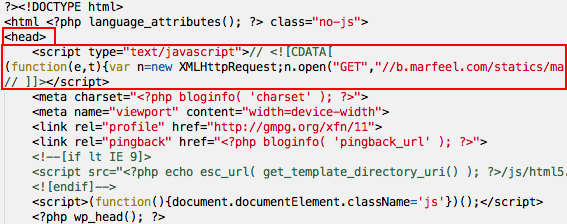Marfeel Garda
The Marfeel solution offers a quick and easy installation. No IT support is required and it can be installed and running in a matter of minutes.
When a Marfeel Progressive WebApp (PWA) is ready to go live after the implementation period, partners receive a line of JavaScript code in an email from their Customer Success Executives. This line of JavaScript just needs to be implemented right after the <head> tag of the publisher's existing web code for every page to be Marfeelized.
From that point on, all mobile users accessing that partner's URL will see a Marfeelized version that delivers an optimal UX that's the backbone of elevated engagement and advertising revenue.
Marfeel's activation code
When Marfeel's activation JavaScript is implemented in a publisher's web code, the site is executed as normal by their servers and their page appears. Marfeel's JavaScript loads behind the scenes just in case the mobile site needs to be loaded. When the JavaScript detects a mobile user, that's when Marfeel works its magic.
In this case, the user is directed to the website's Marfeelized version built from the transformed HTMLs and replaces the DOM (Document Object Model) with the new contents while reusing the same URL.
If a partner would like to test their Marfeel PWA (Progressive WebApp) in their own test environment (subdomain) before activating in production, they should contact their Customer Success Executive.
Importance of Marfeel's activation position
For a Marfeel mobile site to perform optimally, the activation code must be placed at the very top of the <head> tag of the publisher's HTML code for each page they are having Marfeelized.
The position of Marfeel's Garda code is what detects a mobile user and prevents all the extraneous elements meant for the desktop site from rendering. The code not only prevents desktop artifacts from rendering, it also prevents them from loading.
It's this behavior that contributes to the instantaneous load times that optimizes the user experience and drives engagement and revenue.

In some cases, newly activated partners have voiced concerns that their Marfeel mobile sites were not yielding the enhanced load times promised in Marfeel's offer.
After a brief analysis, it's found that these publishers didn't place Marfeel's JavaScript code in the primary position of their <head> tag in HTML, which caused the website to load irrelevant items like CSS files meant for the desktop version, creating a lag in the load.
Google PageSpeed
A great resource to use is Google's PageSpeed tool which provides the rationalization and quantification of page load speed and smoothness.
By entering a URL, the tool performs a quick analysis of the site with both a mobile and desktop user-agent and provides an evaluation of its performance and suggested areas of improvement.
Normally a bad position of the Marfeel Garda code leads to a lower score in a PageSpeed test.